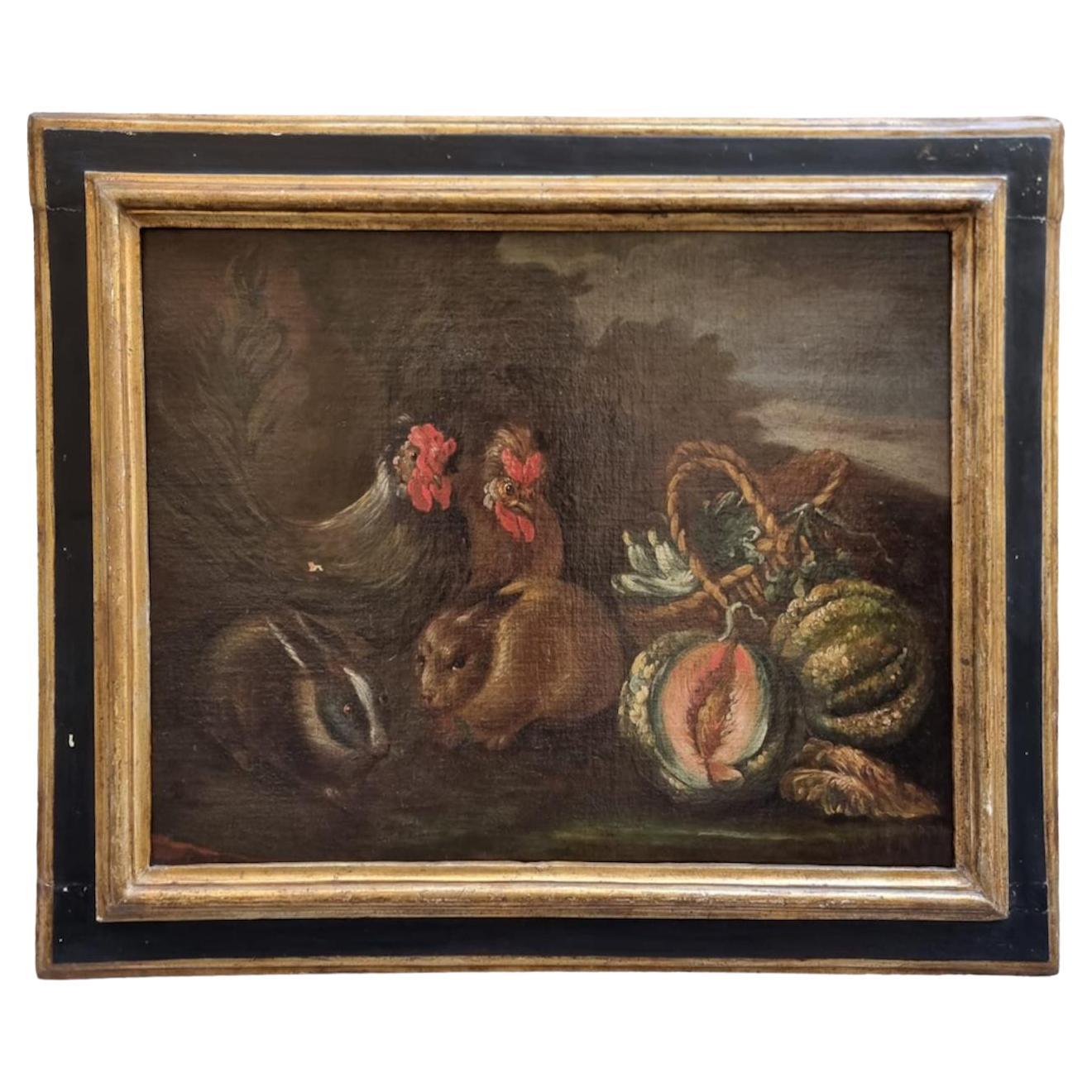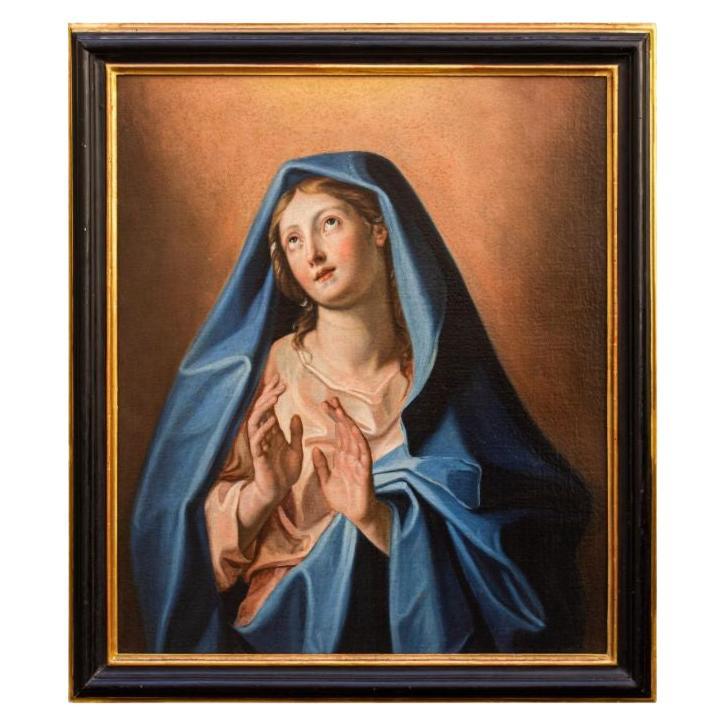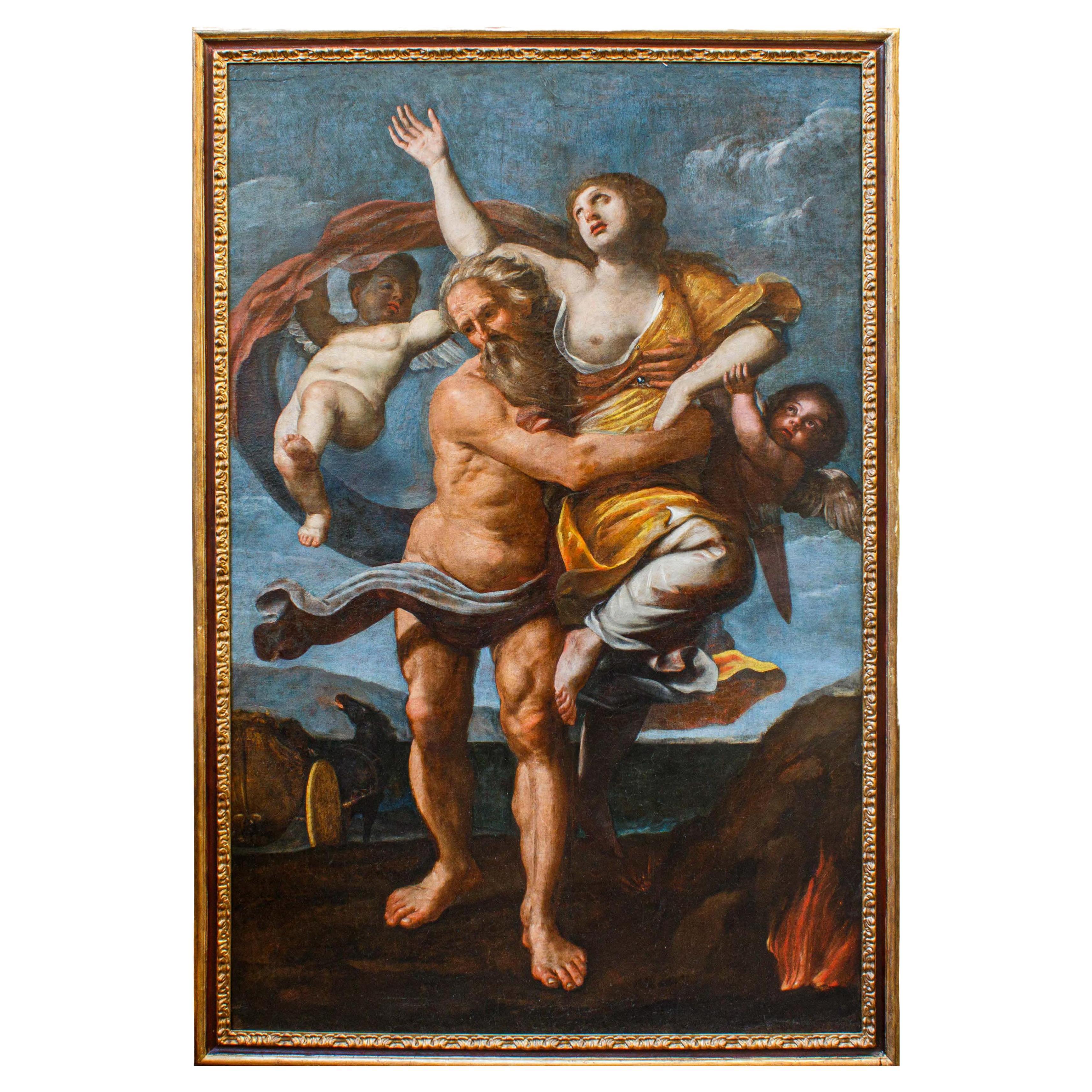Items Similar to Oil painting on canvas depicting Still life Roman school of the 17th century
Want more images or videos?
Request additional images or videos from the seller
1 of 18
Oil painting on canvas depicting Still life Roman school of the 17th century
About the Item
Roman School, 17th century
Still Life
Oil on canvas, 79 x 107 cm
Framed, 93 x 121 cm
The work under scrutiny, depicting a majestic still life of flowers, is ascribed to the 17th-century Roman school, within a multifaceted artistic structure composed of many different personalities who dominated the scene, not only from Italy but also from abroad. In the painting one can see fine details and details such as the embossed bronze vase with a classical flavor, the silver plate bordered by tulips, or even the casket on which a smaller flower vase rests. A dark red velvet cloth is laid partially on top of it to create a balanced and harmonious composition in proportion along with the slender-stemmed flowers collected in the amphora. The latter are distinguished by the looseness of the stroke with which the artist paints them: small touches of the brush illuminate the petals of irises, gerberas, mottled tulips, and the foliage glimpsed in the large bouquet. The light, coming from below, illuminates the scene and creates a pleasant play of shadows and lights that are reflected in the metal of the precious vessels, as observed in the tray, part in shadow and part in light. The painting is easily inscribed in the as-yet insufficiently studied circle of Italian and French artists of the mid-17th century, specialists in the genre of still life with ornamental and precious inserts. The floral composition gives prominence to the luxurious oriental carpets and is played with great virtuosity and always accompanied by gold, silver, or bronze furnishings and sometimes by fruits, flowers, or musical instruments. For comparison, see the still life in a private collection or the one preserved in the BBVA fund in Spain by Jacques Hupin, a French painter active in the mid-17th century in both France and Italy, where he is documented in 1649. Hupin's known paintings depict goldsmithing pieces placed on entablatures covered with heavy carpets with a dark red background. The carpet theme also brings him close to Meiffren Conte and coeval painters active in Bergamo, such as Evaristo Baschenis and Bartolomeo Bettera.
- Dimensions:Height: 36.62 in (93 cm)Width: 47.64 in (121 cm)Depth: 1.97 in (5 cm)
- Materials and Techniques:
- Period:
- Date of Manufacture:17th Century
- Condition:Refinished. Wear consistent with age and use.
- Seller Location:Milan, IT
- Reference Number:1stDibs: LU5918237135082

About the Seller
5.0
Vetted Seller
These experienced sellers undergo a comprehensive evaluation by our team of in-house experts.
Established in 2000
1stDibs seller since 2021
25 sales on 1stDibs
Typical response time: 10 hours
- ShippingRetrieving quote...Ships From: Milan, Italy
- Return PolicyA return for this item may be initiated within 14 days of delivery.
More From This SellerView All
- 17th Century Still Life Painting Oil on Canvas Area of RuoppoloBy Giovan Battista RuoppoloLocated in Milan, ITArea of ??Giovanni Battista Ruoppolo (Naples, 1629 - 1697) Still life with fruit and little bird Measures: Oil on canvas, 62 x 83 cm The still life in question shows juicy citrus fruits, among which we can recognize oranges and cedars, together with red berries scattered on the ground. A cheerful little bird rests on the edge of a terracotta pot in which some pink-mottled carnations grow. The landscape that can be observed all around is veiled by clouds and shaded by shrubs, while in the distance there is a green hill. Dominating the foreground and standing out from the dark background is the fruit which, lush and juicy, stands out in the vivacity of the colors in contrast with the dark background. The full-bodied brushstroke that delineates the wrinkled peel of citrus fruits to restore the realism of the fruit, just as the green leaves of the stems softly folded on themselves are sketched with extreme truthfulness, they ascribe the work to a painter working in the circle of Giovanni Battista Ruoppolo. Ruoppolo is a Neapolitan artist, specialized in the genre of still life, indeed De Dominici himself in his Lives of Neapolitan painters, sculptors and architects recognizes him a primary role in the Neapolitan school of the genre. He studied, together with Giuseppe Recco (1634 -?), In the workshop of Paolo Porpora (1617 - 1673). He painted almost exclusively fruit and flower paintings...Category
Antique 17th Century Italian Paintings
MaterialsCanvas
- Early 17th Century Roman School Praying Madonna Painting Oil on CanvasLocated in Milan, ITRoman school, late 16th-early 17th century Praying Madonna Oil on canvas, 81 x 69 cm Frame 83 x 95.5 cm A divine whiteness reverberates with vibrant luster on the maphorion of the present Virgin. The palpable iridescence that structures the thin rosaceous garment, woven with the same fresh light, produces a slight rustle when she takes her hands off. The Madonna in fact takes a prayerful pose, opening her palms to underline her fervent ecstatic intention; the white neck is rendered with perishable fullness of pigments, like the hands, perfectly alive, and the very shiny eyes. With fine shrewdness the artist of the present styles the Virgin's hair with thin white ribbons, exacerbating the purity. An evocative light falls gently on the bust, a materialized sign of divine glory. The present can be traced back to the late Mannerist climate that prevailed in the capital after the emanation of the Tridentine council (1545-1563). The late Mannerist licenses that can still be seen there, such as the intense lyricism in the stylistic code adopted by the artist, are innervated in the new basic catechetical intent, which at the end of the century produced a certain figurative rigorism. The present, however, still responds to that extraordinary Roman dynamism that raised the capital to a bulwark for the entire mannerist lesson, matched only by a second artistic center, the Florentine one. The engaging carriage of the Virgin reflects the contemporary examples of Giuseppe Valeriano (1542-1596), a Jesuit painter, returning in the Marriage of the Virgin of the Roman Church of Jesus, as well as in the Madonna of Sorrows in the Recanati Altarpiece, equal ardor. But it is in the Assumption of the Virgin painted in four hands with Scipione Pulzone...Category
Antique Early 17th Century Italian Paintings
MaterialsCanvas
- 17th Century Christ and the Samaritan Oil on Canvas Roman SchoolLocated in Milan, ITRoman school of the 17th century Landscape with bridge - Christ and the Samaritan woman at the well Oil on canvas, cm 42 x 59,5 - With frame, cm 54, 5 x 71 cm The small canvas portrays a broad view of the city surrounded by a bucolic and lush landscape, probably a reinterpretation of the Roman countryside or the Agro. The fulcrum of the canvas is the bridge consisting of several bays beyond which stands a village. In the distance the landscape made of green mountains opens into what looks like a lake crossed by boats. The landscape is animated by the human presence; not only small and fleeting figurines intent on walking along earthy paths but also the representation, in the foreground, of an Gospel episode, that of Christ and the Samaritan woman at the well. The landscape can be clearly traced back to a painter trained on the examples of the great seventeenth-century Roman baroque landscape that sees in the Lunette Aldobrandini by Annibale Carracci but also in Claude Lorrain, Nicolas Poussin and Gaspar Doghet are its greatest achievers. If in the past, therefore, the landscape was considered the scenic background on which to project the representation of divine or human characters, in the seventeenth century it became an autonomous and codified pictorial genre. With Carracci comes the so-called ideal landscape: a mental reconstruction of a peaceful and harmonious nature in which the dream of a perfect communion with man is realized. In the wake of Hannibal, as mentioned, during the seventeenth century the "classic" Roman landscape knows a long and happy season by artists such as Domenichino, and the French Claude Lorrain, Nicolas Poussin and Gaspar Dughet. Lorrain investigates the Roman countryside in all its aspects, studying the variations in the different hours of the day, the seasons or weather conditions, but always nourished by a sense of bucolic Virgilian. With Poussin the approach becomes intellectual elaboration and sophisticated rational construction. From the examples of the great masters, the Roman Baroque season, from the middle of the century, saw the flourishing of several personalities who, with shots, but also important personal reworkings, led to further spread the genre. Among the personalities that can be compared to the work in question we cannot fail to mention Crescenzio Onofri (1634-1714), defined by Salerno as the only true pupil of Dughet, who then spread in Florence the taste of the Baroque landscape influencing Tuscan painters such as Panfi and Peruzzini. His paintings are in various Roman collections; such as, for example, the landscapes from the Sacchetti Collection and today at the Pinacoteca Capitolina. and those in the Almagià collection in Rome, others in the Palazzo di Montecitorio, but the most conspicuous group is in the Galleria Doria. In comparison we can mention the two passages of the National Gallery in London, the landscape with a bridge over the Antiquarian Market but also the design of the National Gallery of Art in Washington. In the work you can also find the influences of the art of Giovanni Francesco Grimaldi...Category
Antique 17th Century Italian Paintings
MaterialsCanvas
- 17th century Oil on canvas depicting the Rape of ProserpineLocated in Milan, ITSienese school of the 17th century The rat of Proserpina Oil on canvas, 188 x 123 cm Depicted at the climax of the action, at the height of drama, is the scene of the Rape of Pros...Category
Antique 17th Century Paintings
MaterialsCanvas
- 17th Century Angelica and Medoro Painted Oil on Canvas Roman SchoolLocated in Milan, ITRoman School, 17th century Angelica and Medoro engrave their names on the bark of a tree Oil on canvas, 65 x 48.5 cm The canvas depicts one of the most famous episodes of O...Category
Antique 17th Century Italian Paintings
MaterialsCanvas
- 17th Century Still Life with Birds Painting Oil on Canvas by VictorsBy Jacobus VictorsLocated in Milan, ITAttr. Jacobus or Iacomo Victors (Amsterdam c. 1640 - 1705) Still life with birds Oil on canvas, 112 x 133 cm The still life examined here is a rare example of the simultaneous presence of live and dead animals in a single composition. On two rocky levels different ornithological species are neatly arranged, reproduced with the utmost fidelity and adherence to life. Mallards, doves, sparrows and a partridge placed on their backs can be recognized. The soft mantles with different chromatic tones, with the characteristic streaks and spots of color, together with the precise investigation of the various ornithological typologies, denote an observation of the real datum typical of the seventeenth-century Flemish tradition. Another mallard, this time alive, seems to have just settled on the rock, as if to observe the rich composition moving its neck. Its characteristic colors, the bright green of the head and the upper part of the neck, the yellow of the beak and the orange of the legs characterize the painting and capture the viewer's attention. The flight of the dove in the foreground is splendid, seen from above, the virtuosic pose and the brightness of its feathers, in an elegant modulation of grays tending to white, denote the stylistic quality of this work. It was probably created by a Flemish artist working in Italy in the second half of the seventeenth century: close analogies can be found with the game of Jacobus Victor...Category
Antique 17th Century Dutch Paintings
MaterialsCanvas
You May Also Like
- 17th Century Still Life Oil Painting On CanvasLocated in Firenze, ITStill life oil painting on canvas depicting pumpkins, rabbits and chickens. Tuscany XVII century. The painting needs very small restoration. It has been relined.Category
Antique 17th Century Italian Paintings
MaterialsPaint
- 17th Century Oil Painting On Canvas Depicting AgonizingLocated in Firenze, ITOil painting on canvas depicting Christ and the Madonna consoling a dying man, Emilian school, 17th century.Category
Antique 17th Century Italian Paintings
MaterialsCanvas
- Oil painting on canvas depicting still life 18th centuryLocated in Firenze, ITFine oil on canvas painting of still life, 18th century, France. The painting depicts an arrangement of flowers of various types, a large vase and a basket. One of the special feat...Category
Antique 18th Century French Paintings
MaterialsPaint
- Announcement Italian School Oil on Canvas, of the 17th CenturyBy Europa AntiquesLocated in Madrid, ESAnnouncement Italian School Oil on canvas, of the 17th century Dimension: 75 x 62 cm. Good conditions.Category
Antique 17th Century French Baroque Paintings
MaterialsPaint
- Italian 17th Century Still Life Oil on Canvas from RomeLocated in West Palm Beach, FLA wonderful Italian 17th century still life oil on canvas from Rome. The painting depicts a parrot with fruit at his feet standing next to a vase with a stunning array of colorful an...Category
Antique 17th Century Italian Paintings
MaterialsCanvas, Giltwood
- Italian 17th Century Oil on Canvas Still Life, from RomeLocated in West Palm Beach, FLA stunning Italian 17th century oil on canvas still life, from Rome. The painting depicts a beautiful fruit bowl and grapes in the foreground and wonderfully executed bouquet of flow...Category
Antique 17th Century Italian Paintings
MaterialsCanvas, Giltwood





